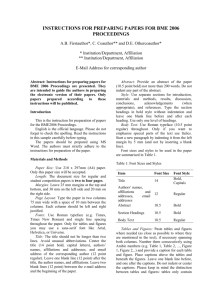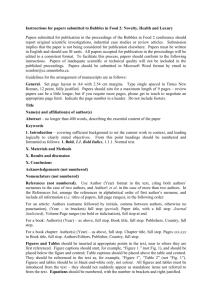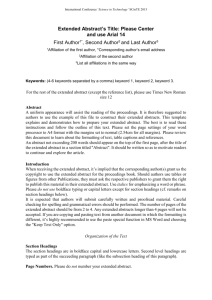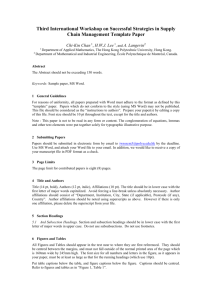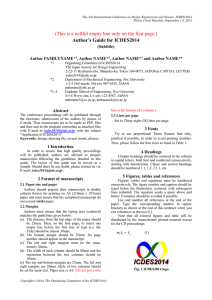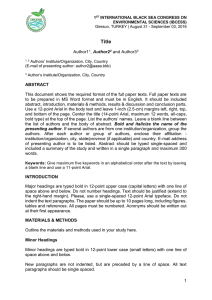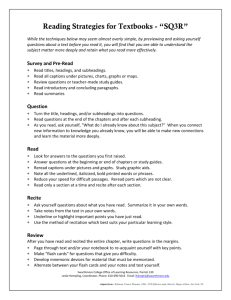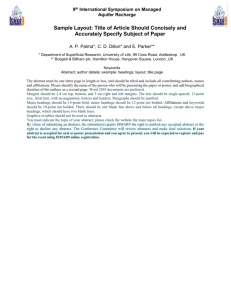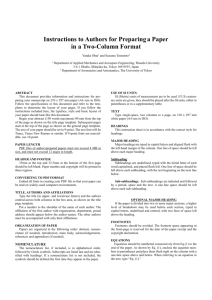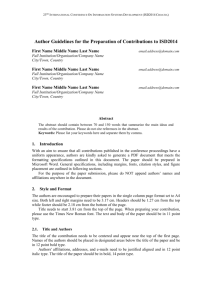Paper Template ()
advertisement
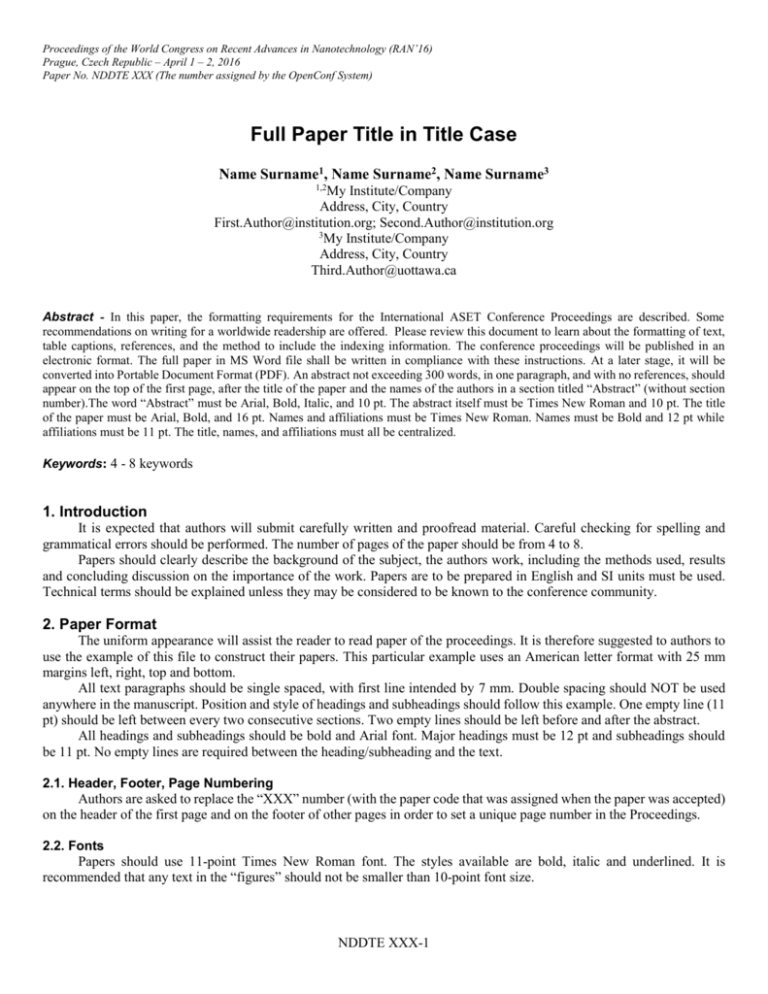
Proceedings of the World Congress on Recent Advances in Nanotechnology (RAN’16) Prague, Czech Republic – April 1 – 2, 2016 Paper No. NDDTE XXX (The number assigned by the OpenConf System) Full Paper Title in Title Case Name Surname1, Name Surname2, Name Surname3 1,2 My Institute/Company Address, City, Country First.Author@institution.org; Second.Author@institution.org 3 My Institute/Company Address, City, Country Third.Author@uottawa.ca Abstract - In this paper, the formatting requirements for the International ASET Conference Proceedings are described. Some recommendations on writing for a worldwide readership are offered. Please review this document to learn about the formatting of text, table captions, references, and the method to include the indexing information. The conference proceedings will be published in an electronic format. The full paper in MS Word file shall be written in compliance with these instructions. At a later stage, it will be converted into Portable Document Format (PDF). An abstract not exceeding 300 words, in one paragraph, and with no references, should appear on the top of the first page, after the title of the paper and the names of the authors in a section titled “Abstract” (without section number).The word “Abstract” must be Arial, Bold, Italic, and 10 pt. The abstract itself must be Times New Roman and 10 pt. The title of the paper must be Arial, Bold, and 16 pt. Names and affiliations must be Times New Roman. Names must be Bold and 12 pt while affiliations must be 11 pt. The title, names, and affiliations must all be centralized. Keywords: 4 - 8 keywords 1. Introduction It is expected that authors will submit carefully written and proofread material. Careful checking for spelling and grammatical errors should be performed. The number of pages of the paper should be from 4 to 8. Papers should clearly describe the background of the subject, the authors work, including the methods used, results and concluding discussion on the importance of the work. Papers are to be prepared in English and SI units must be used. Technical terms should be explained unless they may be considered to be known to the conference community. 2. Paper Format The uniform appearance will assist the reader to read paper of the proceedings. It is therefore suggested to authors to use the example of this file to construct their papers. This particular example uses an American letter format with 25 mm margins left, right, top and bottom. All text paragraphs should be single spaced, with first line intended by 7 mm. Double spacing should NOT be used anywhere in the manuscript. Position and style of headings and subheadings should follow this example. One empty line (11 pt) should be left between every two consecutive sections. Two empty lines should be left before and after the abstract. All headings and subheadings should be bold and Arial font. Major headings must be 12 pt and subheadings should be 11 pt. No empty lines are required between the heading/subheading and the text. 2.1. Header, Footer, Page Numbering Authors are asked to replace the “XXX” number (with the paper code that was assigned when the paper was accepted) on the header of the first page and on the footer of other pages in order to set a unique page number in the Proceedings. 2.2. Fonts Papers should use 11-point Times New Roman font. The styles available are bold, italic and underlined. It is recommended that any text in the “figures” should not be smaller than 10-point font size. NDDTE XXX-1 2.3. Tables and Figures Tables and figures should be placed close to their first citation in the text. All figures and tables should be numbered. Table headings should be centred above the tables. Figure captions should be centred below the figures. Refer to the figure below for a sample. Fig. 1: Caption for figure goes at the bottom. Figure captions and table headings should be sufficient to explain the figure or table without needing to refer to the text. Figures and tables not cited in the text should not be presented. Refer to the tale below for a sample. Table 1: Caption for table goes at the top. 2.4. Equations Each equation should be presented on a separate line from the text with a blank space above and below. Equations should be clear and expressions used should be explained in the text. The equations should be numbered consecutively at the outer right margin, as shown in Eqs. (1) - (2) below. Here is one example. In this case, the governing system of equations can be written as follows: ∂𝜌 = −∇ ∙ (𝜌 𝐮) ∂𝑡 𝜕 1 𝜌 ( + 𝐮 ∙ ∇) 𝐮 = −∇𝑃 + 𝜌𝐠 + 𝐉 × 𝐁 𝜕𝑡 𝒄 𝜕 1 𝜌 (𝜕𝑡 + 𝐮 ∙ ∇) 𝑒 = −𝑃∇ ∙ 𝐮 + 𝜌𝐮 ∙ 𝐠 + σ 𝐉 2 (1) (2) (3) 3. Submitting the Paper The full paper has to be submitted electronically via the website of the conference (http://icnfa.com/OpenConf/) by the deadline (see website for details). Paper number (in the format “XXX”) is assigned to each abstract after it was accepted and authors are kindly asked to place the paper number to the correct positions in the header and footer before submitting the final version. NDDTE XXX-2 4. Conclusion Conclusions should state concisely the most important propositions of the paper as well as the author’s views of the practical implications of the results. Acknowledgements A short acknowledgement section can be written between the conclusion and the references. Sponsorship and financial support acknowledgments should be included here. Acknowledging the contributions of other colleagues who are not included in the authorship of this paper is also added in this section. If no acknowledgement is necessary, this section should not appear in the paper. References The IEEE citation format is used. Books and book chapters should be referenced as [1] and [2] respectively. Patents are referenced based on [3] and a thesis can be referenced as [4]. Finally, conference presentations/papers and journal papers need to be reference based on [5] and [6] respectively. With the increasing availability of useful information that can be found on the internet, website references must also be reported based on [7]. Meanwhile, due to the dynamic nature of web pages and the fact that in most cases the information is not peer-reviewed, the use of published resources are very much preferred and advised over online references. The reference section at the end of the paper should be edited based on the following: [1] B. Klaus and P. Horn, Robot Vision. Cambridge, MA: MIT Press, 1986. [2] L. Stein, “Random patterns,” in Computers and You, J. S. Brake, Ed. New York: Wiley, 1994, pp. 55-70. [3] J. P. Wilkinson, “Nonlinear resonant circuit devices,” U.S. Patent 3 624 125, July 16, 1990. [4] J. O. Williams, “Narrow-band analyzer,” Ph.D. dissertation, Dept. Elect. Eng., Harvard Univ., Cambridge, MA. [5] U. V. Koc and K. R. Liu, “Discrete-cosine/sine-transform based motion estimation,” in Proceedings of the IEEE International Conference on Image Processing, Austin, TX, 1994, vol. 3, pp. 771-775. [6] R. E. Kalman, “New results in linear filtering and prediction theory,” J. Basic Eng., vol. 83, no. 4, pp. 95-108, 1961. [7] K. Author. (2015, May 10). Facility Greenhouse Gas Reporting (2nd ed.) [Online]. Available: http://www.ec.gc.ca/gesghg/default.asp?lang=En&n=040E378D-1 NDDTE XXX-3
